Notes: Animal Kingdom | EVS & Pedagogy Paper 1 for CTET & TET Exams - CTET & State TET PDF Download
In our surroundings, we find different types of animals ranging from mammals, reptiles, birds, amphibians, insects and many other smaller forms. Animals may live on land or in water or fly in air, depending upon their abilities and nature. Animals are capable of movement and they move from one place to another.
Habitat of Animals
- A habitat is a place where living things live and survive. Animals have basic needs like air, water, food, shelter, and space. They live in habitats where they are best adapted.
- Animals can be classified based on their habitats:
i) Land Animals: These animals live on land and in trees. Examples include mammals, birds, and reptiles.
ii) Water Animals: These animals live in water bodies. Examples include fish, crabs, and sponges.
iii) Land and Water Animals: Animals that can live in both land and water are called amphibians. Examples include frogs, toads, salamanders.
iv) Aerial Animals: Birds and insects are examples of animals that primarily live in the air.
Classification of Animals
Animals are mostly multicellular organisms in the kingdom Animalia or Metazoa.
I. Classification Based on Body Structure: Animals are categorized based on the presence of a vertebral column (backbone) into vertebrates and non-vertebrates.
- Vertebrates: Animals with a vertebral column/backbone. Examples include mammals, birds, fish, reptiles, and amphibians.
- Non-vertebrates: Animals without a vertebral column/backbone. Examples include insects, crabs, snails, and starfish.

II. Classification Based on Nutrition:
- Autotrophs: Organisms that produce complex organic compounds (carbohydrates) from carbon dioxide and water using chlorophyll and sunlight.
- Heterotrophs: Organisms that cannot produce their own food and depend on plants and other organisms to survive.

III. Classification Based on Cell:
- Unicellular organisms: Organisms with a single cell that relies on that one cell for all life processes. Examples include Amoeba, Paramecium, and Euglena. (These organisms can be seen under a microscope.)
- Multicellular organisms: Organisms that consist of more than one cell. All species of animals, land plants, and most fungi are multicellular.
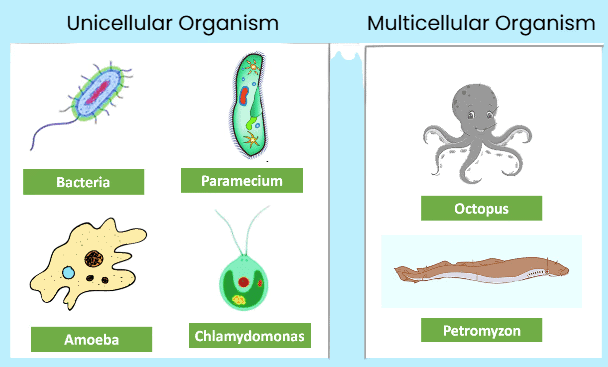
IV. Classification Based on Reproduction:
- Viviparous Animals: Animals that give birth to live young ones. The zygote develops into young ones inside the female's body, leading to higher chances of survival due to proper embryonic care and protection. Examples include whales, dolphins, dogs, cats, and humans.
- Oviparous Animals: Animals that lay fertilized or unfertilized eggs, from which young ones hatch after a period of incubation. The chances of survival for young ones are lower because eggs are laid in the open environment. Examples include fishes, amphibians, reptiles, birds and most insects.
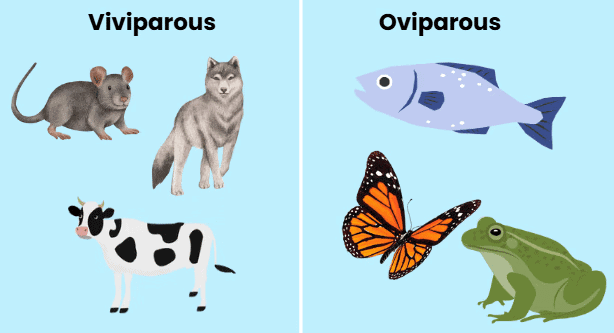
V. Classification Based on Habitat:
- Terrestrial Animals: Animals that live predominantly or entirely on land. Examples of terrestrial habitats include forests, grasslands, wetlands, and deserts. Examples include bears, cats, dogs, deer, ants, and snails.
- Aquatic Animals: Animals that can only live in water. These include freshwater habitats like rivers, streams, lakes, and ponds, as well as marine habitats like brackish water marshes, estuaries, bays, and the open sea. Examples include fish, octopus, lobsters, and seahorses.
- Amphibians: Animals that can live both on land and in water. They have moist, slimy, and permeable skin, and they primarily live in moist places or close to water to prevent their bodies from drying out. Deserts are not suitable habitats for amphibians due to their need for water to keep their skin moist and for the development of their young. Examples include frogs, toads, and salamanders.
- Arboreal Animals: Animals that live primarily in trees. They eat, sleep, and play in the tree canopy. Examples include squirrels, chameleons, monkeys, various rodents, and parrots.

VI. Classification Based on Body Temperature:
- Warm-blooded animals: Animals that can regulate their body temperature. Examples include mammals and birds.
- Cold-blooded animals: Animals that cannot regulate their body temperature. Examples include reptiles, fishes, amphibians, and insects. These animals may also exhibit hibernation (winter sleep) and aestivation (summer sleep).
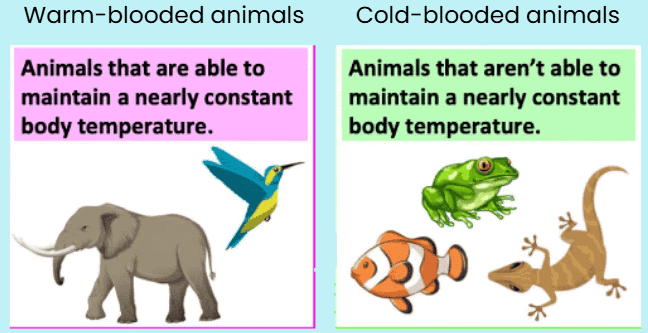
VII. Classification Based on Food Habits:
- Carnivores: Animals that feed on other animals or flesh. Examples include lions, tigers, sharks, whales, eagles, and vultures. They have sharp, pointed, and curved front teeth, as well as strong grinding teeth at the back of their mouths.
- Herbivores: Animals that feed on plants and leafy materials. Examples include elephants, cows, and rabbits. Herbivores have sharp, flat, and broad front teeth for plucking and biting leaves, as well as strong and flat back teeth for chewing food.
- Omnivores: Animals that feed on both plants and flesh. Examples include dogs, cats, hens, mynahs, and bears.
- Decomposers: Organisms that break down dead and decaying organisms. Decomposers help form the humus layer of the soil. They are heterotrophic in nature. An example of a decomposer is fungus or bacteria, which break down organic matter into simpler substances.
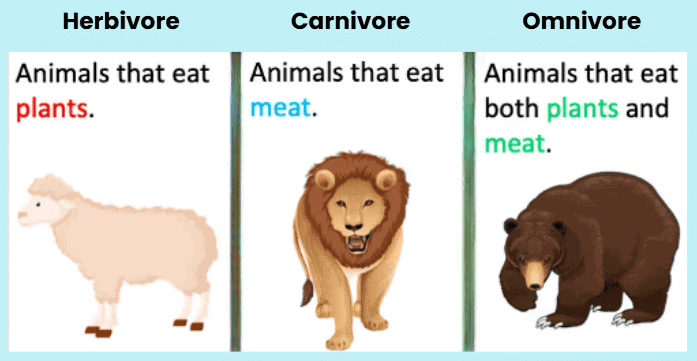
Relationships between Organisms
Different organisms have various types of relationships with each other, where one organism benefits while the other is unaffected. These relationships are explained below:
1. Commensalism
In this type of relationship, one organism benefits while the other is neither harmed nor helped. For example:
- Egret birds and grazing cattle have a close association where the egret benefits by feeding on insects disturbed by the cattle.
- Orchids growing as epiphytes on a mango branch receive nutrients and support without harming the tree.
- Barnacles growing on the back of a whale benefit from the whale's movement through water, gaining access to food without affecting the whale.
2. Mutualism/Symbiosis
In this relationship, both organisms benefit from each other. For example:
- Lichens are a symbiotic relationship between fungus and photosynthesizing algae or cyanobacteria, where the fungus provides a protective environment and the algae or cyanobacteria produce food through photosynthesis.
- Mycorrhizae involve a symbiotic relationship between fungi and the roots of higher plants, where fungi enhance nutrient absorption for the plant, and in return, the plant provides carbohydrates to the fungi.
3. Parasitism
In this type of relationship, one species benefits at the expense of the other. For example:
- Human liver fluke is a parasite that lives in the liver of humans, causing harm.
- Malaria parasite transmitted by mosquitoes, infects and harms humans.
- Lice infesting humans cause discomfort and health issues.
4. Predation
Predation occurs when one organism eats another to obtain nutrients. In this relationship, one organism is the prey that is eaten, and the other is the predator that does the eating. For example:
- Pitcher plant is a plant that traps and digests insects to obtain nutrients.
5. Competition
In this relationship, organisms compete for the same resource. For example:
- Flamingoes and fishes compete for zooplankton in the lake as a food source.
Respiration in Animals
- Respiration is the process through which animals take in oxygen and exchange it for carbon dioxide and water as waste products. Animals require oxygen and energy to survive.
- Humans and terrestrial mammals, as well as birds, reptiles, and amphibians, breathe using lungs. However, fishes and amphibians primarily use gills for breathing.
- Earthworms respire through their moist skin, while various other microorganisms and animals breathe through specific pores, openings, or their entire body surface.
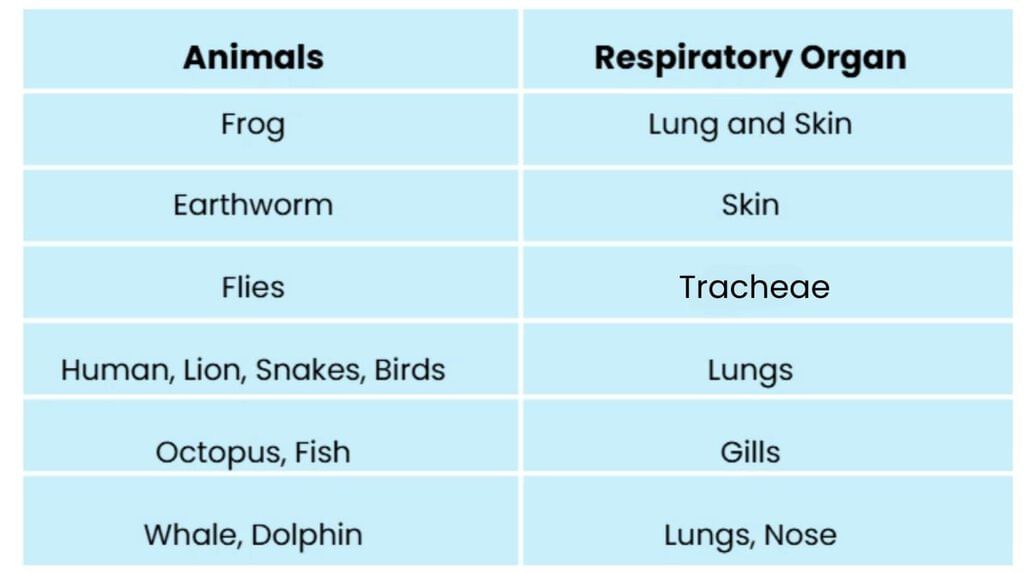
Reproduction in Animals
Animals can be classified into two types based on their mode of reproduction:
1. Oviparous Animals: These animals lay eggs. Examples include birds, reptiles, amphibians, fish, etc.
2. Viviparous Animals: These animals give birth to their young ones. Examples include mammals.
Types of Fertilization in Animals
There are two kinds of fertilization in animals: 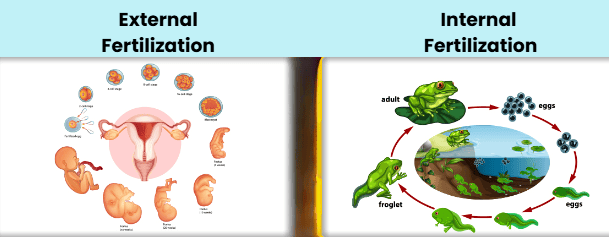
1. External Fertilization: This occurs when the ovum and sperm unite outside the body of the female. Examples include fish, frog, etc.
2. Internal Fertilization: This occurs when the ovum and sperm unite inside the body of the female. Examples include reptiles, mammals, birds, etc.
After fertilization, the development of the embryo occurs inside the female body if the animal is viviparous. Otherwise, the embryo develops outside the body. Most viviparous animals have mammary glands, hair on their skin, and visible ears.
Locomotion in Animals
Animals have different structures that help them move. They move from one place to another to find safety, shelter, food, and a mate. For example:
- Mammals usually move using their legs.
- Fish use fins to swim.
- Birds fly with their wings.
- Reptiles either walk on legs or crawl using their bodies.
- Frogs have webbed feet for swimming.
- Penguins use flippers to move in water.
- Insects have many legs to walk or crawl.
1. Pedestal Animals
- These animals walk as a means of locomotion. Examples include humans, lions, dogs, cats, and cows.
2. Creeping Animals
- These animals move by creeping. Examples include snakes, worms, caterpillars, and earthworms.
- Snakes move with the help of muscles and their scales.
- Earthworms move using bristles by contracting and relaxing their skin muscles repeatedly.

3. Flying Animals
- Birds are the primary flying animals. They are lightweight as an adaptation for flight.
- Examples of non-flying birds include ostriches and emus, which run instead of flying.
- Owls can almost fully rotate their heads because their eyeballs cannot rotate; their eye sockets are fixed.
4. Swimming Animals
- Fish and frogs are examples of swimming animals. Swans and ducks also prefer to swim.
- Frogs are also considered leaping animals.
Sense Organs and Stimulation in Animals
Animals on Earth have five senses: eyes, ears, nose, tongue, and skin. These sense organs help animals perform various activities, such as:
- Birds like kites, eagles, and vultures can see things four times better than humans, helping them spot prey from a distance.
- Ants identify their group by a specific odour they release.
- Some insects are attracted to their mates by smell, such as silkworms.
- Mosquitoes can find humans in the dark by the odour of the body, body heat, and the smell of the soles of the feet.
- Birds can see in different directions at once because their eyes are on the sides of their heads.
- Elephants blow air into their ears while listening; their ears also help regulate body temperature.
- Dogs, lions, and tigers can identify their territory or den by the smell of their excreta.
- Frogs and lizards use their tongues to catch prey.
- Nocturnal animals, like owls and raccoons, can only see in black and white.
- Snakes do not have noses; they smell with their tongues. They also do not have ears, so they sense vibrations through the ground to detect prey or danger.
- Bats are mammals because they give birth to live young.
- Squirrels are rodents with four front teeth that never stop growing, preventing them from wearing down from constant gnawing.
- Tigers can differentiate between the sound of rustling leaves and an animal moving on grass.
- Cockroaches are organisms that can both walk and fly.
Benefits of Animals
Animals play a significant role in the environment. Some animals are highly beneficial to humans. Here are a few examples: 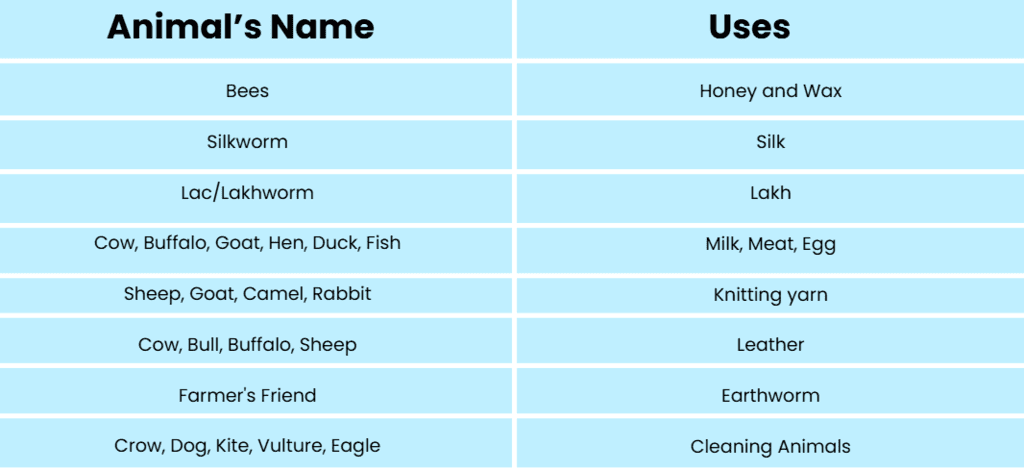
Specific Features of Specific Class of Animals
Pisces/Fishes
- Fishes have scales on their bodies and invisible ears. They possess a two-chambered heart and are oviparous, meaning they lay eggs.
Amphibians
- Amphibians lack scales but have invisible ears. They have a three-chambered heart and breathe through gills, lungs, and skin. Like fishes, amphibians reproduce by external fertilization and are oviparous. Examples include frogs, tadpoles, etc.
Reptiles
- Reptiles have scales on their bodies. Like birds and fishes, they have hidden ears. They breathe through lungs and have a three-chambered heart. Reptiles reproduce by laying eggs (oviparous). Examples include snakes, lizards, and tortoises.
- Reptiles, such as snakes, detect sound through vibrations from the ground. Snakes lack external ears and can only feel vibrations from the surface. They have two hollow teeth, called fangs, through which poison is injected when they bite.
- Medicines for snake bites are derived from snake venom. Among the various snake species in India, only four are venomous: Cobra, Krait, Russell’s Viper (Duboiya), and Saw-Scale Viper (Afa).
Birds
- Birds have a unique set of characteristics that distinguish them from other animals.
- They are warm-blooded vertebrates covered in feathers, with a beak and wings. Birds lay eggs, and some species, like ducks and penguins, are adapted for swimming.
- Examples of birds include eagle, pigeon, parrot, sparrow.

Body Structure and Features of Birds
- Birds have a boat-shaped body, hollow bones, wings, and feathers that enable them to fly.
- They possess a four-chambered heart, which helps in the efficient circulation of blood.
- Birds have a fixed eye position, so they move their necks to see in different directions. The owl can rotate its neck nearly 360°, while the mynah can move its neck back and forth with a jerk.
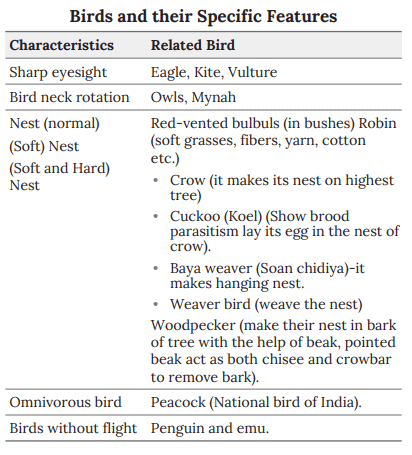
Brood Parasite
- Brood parasites are organisms that rely on others to raise their young.
- The koel is a brood parasite that lays its eggs in the nest of a crow, relying on the crow to incubate and raise its young.
Animal Husbandry
Animal husbandry is the science of breeding and caring for animals, focusing on the management of animals that are commercially important to humans. This includes the production of various animal products. 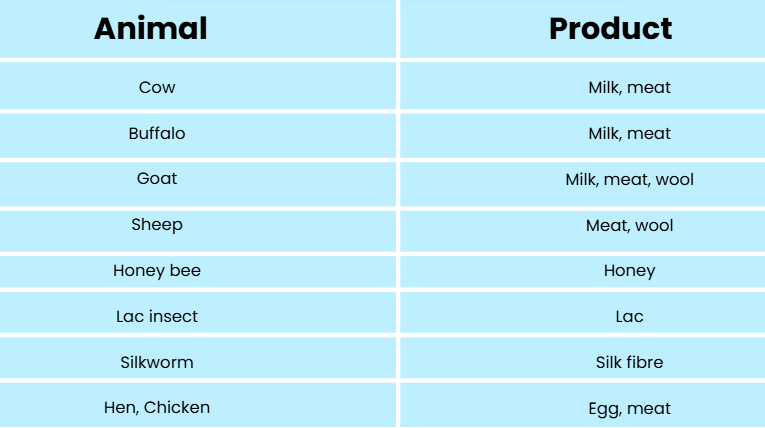
Dairy Animals
- Dairy animals are raised for their ability to produce large quantities of milk, which is used to make various dairy products such as cheese, butter, mawa (condensed milk solid), and sweets.
- Cows, buffaloes, and goats are commonly reared as dairy animals.
- Cow’s milk generally contains less fat than buffalo’s milk.
- Goats are often referred to as the 'poor man’s cow' due to their ability to produce milk in smaller quantities.
Poultry Animals: Poultry animals, such as chickens and ducks, are raised for their eggs, which are a rich source of protein.
To Carry Weight: Horses and donkeys are used to carry heavy loads and transport goods.
For Agriculture: Bulls are used in agricultural activities such as plowing and tilling the land.
Pet Animals
- A pet or companion animal is an animal kept primarily for a person's company, protection, or entertainment rather than as a working animal, sport animal, or livestock.
- Pets provide their owners with physical and emotional benefits.
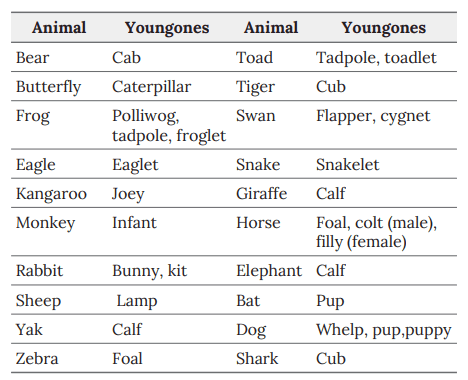
Bee-Keeping (Apiculture)
- Honey bees are attracted to the flowers of litchi trees.
- The best time to start bee-keeping in the state of Bihar is from October to December, when honey bees lay their eggs.
- Each beehive contains one queen bee responsible for laying eggs, while most of the bees in the hive are worker bees, with a few male bees.

Impact of Animals on Children
- The presence of animals in a child's surrounding influences their behavior.
- Studies have shown that playing with pets can reduce stress in children.
- Children develop affection for domesticated animals, such as dogs, cats, cows, rabbits, parrots, pigeons, etc.
- They tend to develop a sense of fear of animals they are not familiar with or have learned are dangerous.
- By observing the actions of animals like ants, spiders, and squirrels, children's curiosity is piqued, prompting them to seek answers and develop critical thinking skills.
|
21 videos|139 docs|35 tests
|
FAQs on Notes: Animal Kingdom - EVS & Pedagogy Paper 1 for CTET & TET Exams - CTET & State TET
| 1. What are the different habitats of animals and how do they adapt to them? |  |
| 2. How are animals classified into different groups? |  |
| 3. What are the primary types of respiration in animals? |  |
| 4. How do animals reproduce, and what are the differences between sexual and asexual reproduction? |  |
| 5. What are the significant sense organs in animals and their functions? |  |

















